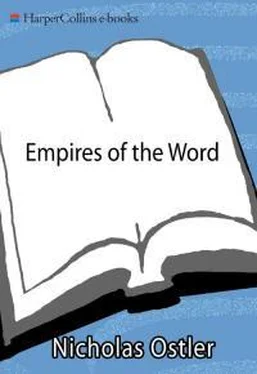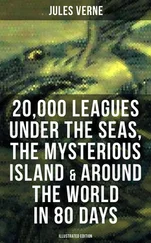In a way, trying to get a Greek view of the Romans to compare with their view of the Celts or Germans is unrewarding. The Celts and Germans may have been entertaining strangers, but after the second century BC the relationship between the Greeks and the Romans became more like a marriage (see Chapter 6, ‘A Roman welcome: Greek spread through culture’, p. 250). The Slavs, on the other hand, became a factor in the language map of Europe only when they forcibly made their presence felt on the Greeks. Understandably, there is little sympathetic insight in the early Greek descriptions, which were in any case written much later, when they were bearing down on the Balkans and Greece itself (see Chapter 6, ‘Intimations of decline’, p. 262). Prior to this, though, Tacitus (in his Germania , AD 98) has some remarks to make on their ancestors, the Veneti (latterly known as the Wends, or Sorbs) and Fenni (whose name was later given to the Finns, but who may have been Slavs).
The tribes of Peucini, Venethi and Fenni, I hesitate whether to classify as Germans or Sarmatians… [451]The Venethi have brought many customs from them [the Sarmatians]: they prey on the whole range of woods and mountains between the Peucini [in the south] and the Fenni [in the north]. But they are more like Germans, since they build houses, use shields, and like to move on foot and fast: this is all very different from the Sarmatians who live in wagons and on horseback. The Fenni’s savagery is amazing, their poverty appalling: they have no arms, no horses, no homes: they live on grass, dress in skins, sleep on the ground; their only resource is arrows, sharpened with bone for lack of iron. The same hunting sustains both men and women: they accompany each other everywhere, and claim their share of the prey. The children have no shelter from beasts or showers beyond the covering woven from branches, and this is where youths return, and old people take refuge. But they think this is happier than groaning in fields, working in houses, and trying their and others’ fortunes in hope and fear; they have no care for people, no care for gods, but have achieved something of outstanding difficulty, not even to need to wish for anything. [451]
The Veneti also appear in the pages of Ptolemy, mid-second century AD, as the Ouenédai , a ‘very large nation occupying Sarmatia along the whole Venetic Gulf’. Apparently then they were living along the Baltic shore. [451]
Rún: The impulsive pre-eminence of the Celts
Rún: (a) something hidden or occult, a mystery; hidden meaning; (b) a secret; (c) secret thoughts or wishes, intention, purpose; (d) full consciousness, knowledge; (e) darling, love.
Royal Irish Academy, Dictionary of the Irish Language
Celtic origins are obscure, but when first heard of this culture was already seated at the heart of western Europe.
Archaeologically, they are identified with the culture, or rather succession of cultures, typified first by the Hallstatt site in Austria (dated thirteenth to sixth centuries BC), and then by the La Tène site on Lake Neufchštel in Switzerland (from the sixth to the first century BC). Together with comparable sites, these defined the Iron Age way of life as experienced in central Europe. Their material goods, well preserved by salt and by marshland respectively in the two sites, include weapons, bronze and ceramic vessels, jewellery, clothing, wooden tools, pins, buckles, razors and wheeled vehicles. The decorative style with elaborate swirls and spirals, which we still see as Celtic, is very much in evidence.
This, then, defined the home life of our Celts. What of their linguistic existence?
Traces of Celtic languages
The longest-lasting, and most widely broadcast, evidence of the spread of Celtic languages is given by their place names: Celtic place names have a certain feel to them. Towns set up by Celts would often have suffixes such as - dūnum , ‘fort’, - brīga , ‘hill’, - magus , ‘plain’, - brīva , ‘crossing’, - bona , ‘settlement’ or ‘spring’. There is also a recognisably Celtic tendency to self-congratulation: sego -, ‘powerful’, uxello -, ‘high’. Such names can be found from the north of Britain (Uxellodunum to Segedunum at either end of Hadrian’s Wall) to the very south of Iberia (Caetobriga—Setúbal, just south of Lisbon), and from the English Channel (Rotomagus—Rouen) to the Danube (Vindobona—Vienna, Singidunum—Belgrade). The snag is that such etymologising is so easy it may even have led to some towns being given a Celtic name for purely sentimental reasons. It is noticeable that many of them were created under Roman rule: Iuliobona, Augustodurum, Caesaromagus in Gaul, Flaviobriga, Augustobriga, Iuliobriga in Spain. A single place name is hardly evidence that the language from which it is drawn was spoken when the name was given.
It is also possible just to take the testimony of people, usually Greeks or Romans, who met or knew of Celts in different parts of Europe. Strabo records that three tribes of Gauls, the Boii, [834]Taurisci and Scordisci, were mixed up with the Thracians, which would place them towards the Balkans. He also says that the Scordisci lived near where the Noaros, the river swelled by the Kolapis, flows into the Danube. [451]Now a look at the map shows that the river swelled by the Ku(l)pa is in fact the Sava, and it flows into the Danube at Singidunum, modern Belgrade. Strabo is quite careful to distinguish Gauls from other races, for example noting that the Bastarnae may be considered Germans (vii.3.17), and that the Dacians and Getai speak the same language (vii.3.13). Although he makes no explicit reference to the language of these Gauls, it would seem that in the first century AD some form of Gaulish would have been spoken not just in southern Germany, but down into what is now Croatia and Serbia. [835]
Finally, there is the evidence of what languages are spoken where today. The Celtic languages spoken in the British Isles up to the present day are the direct descendants of the indigenous tongues that the Romans heard about them over the four hundred years when Britain was occupied, and Ireland was visited occasionally. There is also a continuing Celtic-language tradition in the Breton corner in the north-west of France, even if it remains unclear whether this has been strictly unbroken; i.e. whether Breton is a continuation of Gaulish, or a reimport of the language from Cornwall in the first millennium AD. Perhaps it is both, remixed.
Whatever the travels that took them there by the third century BC, we therefore have evidence of a variety of peoples most likely speaking Celtic, predominating in western Europe and its islands but extending right round the Alps north and south, and on into Dalmatia. They were predominantly settled populations, living in farming villages with roads linking them. Latin has shown up one characteristic of contemporary Gaul by (quite consciously, it seems) borrowing from Gaulish so many words for wheeled vehicles: benna , ‘buggy’, carrus , ‘hand-cart’, cisiwn , ‘cabriolet’, carpentum , ‘carriage’, essedum , ‘war chariot’, raeda , ‘coach’. Indeed, magnificent four-wheeled carriages are significant grave-goods in many of the La Tène graves. So although basically settled, Gaulish society could also be very mobile when it chose.
But for linguists, the hardest evidence of where and when the language was used comes from writing. Since none of the Celts had a written literary tradition until fifth-century AD Ireland, this means that we are largely reliant on inscriptions. These come from many different places. Celts appear to have been literate only where they had neighbours who could teach them. And the places where this happened are far flung indeed, though naturally they tend to be on the margins of Celtic-speaking areas. Sadly, but unsurprisingly, they do not include sites equated with the Hallstatt or La Tène cultures.
Читать дальше











